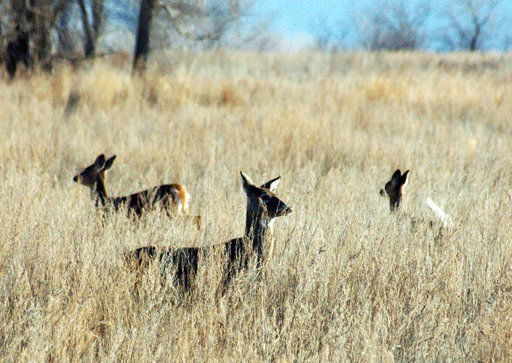BISMARCK, N.D. — More deer in southwestern North Dakota have tested positive for chronic wasting disease, but state wildlife officials remain optimistic they can keep the deadly ailment from spreading throughout the state where deer hunting is a major economic contributor.
A white-tailed buck and a mule deer doe killed by hunters in unit 3F2 last fall tested positive for the fatal disease that strikes the nervous system in deer, elk and moose. Eleven cases have now been confirmed in that unit since the disease was first detected in North Dakota there in 2009 in a deer that presumably wandered in from South Dakota.
The unit is about 2,900 square miles, but 10 of the 11 cases have been clustered in an area of only about 5 square miles, according to state Game and Fish Department Wildlife Chief Jeb Williams.
"The cases that were detected this year are right in the heart of where we detected cases in previous years," said Stephanie Tucker, leader of the agency's Game Management Section. "The distribution of the disease doesn't seem to have grown."
No CWD infections have been reported in people, but the federal Centers for Disease Control and Prevention recommends hunters have animals tested if they're from areas where the disease is present, and not eat meat from infected animals.
Any proliferation of chronic wasting disease in North Dakota could hurt a hunting industry worth tens of millions of dollars to the state. Each resident deer hunter spends about 7 days in the field, shelling out an average of about $136 each day. Nonresident hunters average about five days afield and spend $226 daily, according to state Tourism Division data.
"The department takes the risk of CWD to the state's deer, elk and moose herds seriously," said Dan Grove, Game and Fish wildlife veterinarian.
Game and Fish since 2010 has restricted the transportation of certain deer parts from the 3F2 hunting unit and also has banned baiting in the region, since bait piles can spread disease. Violations carry a $100 fine.
Those restrictions appear to be working, Williams and Tucker said, and wildlife officials don't believe the spread of chronic wasting to herds in other parts of North Dakota is imminent. The state has a surveillance program that collects deer heads voluntarily from hunters for testing, and more than 31,000 deer, elk and moose have tested negative since 2002.
Still, the state will be studying if there might be other ways to try to prevent the spread of the disease beyond 3F2, Tucker said. Officials also have taken steps to try to stop the disease from being brought in from other states.
Game and Fish late last year added Montana to the list of states from which the movement of deer carcasses into North Dakota is restricted, after chronic wasting was discovered there. Montana became the 23rd state on North Dakota's list, which also includes the other neighboring states of South Dakota and Minnesota and the Canadian province of Saskatchewan to the north.
Such restrictions can't stop live infected animals moving in on their own, which is one of the greatest risks for spreading the disease into new areas, according to the nonprofit Chronic Wasting Disease Alliance. However, "areas where it's been found in (neighboring) states are fairly distant from the North Dakota border," Tucker said.
Alliance data back that up, showing documented cases in the wild in southeastern Minnesota, southwestern South Dakota and south central Montana — all far from North Dakota.
___
Follow Blake Nicholson on Twitter at: http://twitter.com/NicholsonBlake


